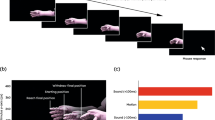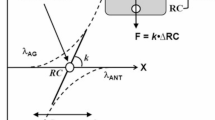Abstract
Humans display accurate limb behavior when they move in familiar environments composed of many simultaneously-acting forces. Little is known about how multi-force environments are represented and whether this process partitions between the underlying force components, reflects the net forces present, or is cued to the force-context. We tested between these three main alternatives by examining how reaching movements adapt to a novel multi-force field composed of a velocity-dependent force and a constant force. These hypotheses were dissociated first by making the constant force larger and oppositely-oriented to the velocity-dependent force; thereby, the net force was always opposite the velocity-dependent component. Second, we tested adaptation with all novel forces removed to eliminate any potential cues for the force-context. In two experiments that used forces perpendicular or parallel to the forward movement direction, we found adaptation aftereffects consistent with a mechanism that partitioned the velocity-dependent component from the net force field. Specifically, we found aftereffects opposite the rightward or resistive velocity-dependent component of the multi-force field, even though the net force imposed was leftward or assistive, respectively. An additional experiment suggested that the velocity-dependent component is partitioned relative to the background load in a limb-based coordinate frame.








Similar content being viewed by others
References
Atkeson CG, Hollerbach JM (1985) Kinematic features of unrestrained vertical arm movements. J Neurosci 5:2318–2330
Baroni G, Pedrocchi A, Ferrigno G, Massion J, Pedotti A (2001) Static and dynamic postural control in long-term microgravity: evidence of a dual adaptation. J Appl Physiol 90:205–215
Bennett DJ (1994) Stretch reflex responses in the human elbow joint during a voluntary movement. J Physiol 474:339–351
Berger M, Mescheriakov S, Molokanova E, Lechner-Steinleitner S, Seguer N, Kozlovskaya I (1997) Pointing arm movements in short- and long-term spaceflights. Aviat Space Environ Med 68:781–787
Blakemore SJ, Goodbody SJ, Wolpert DM (1998) Predicting the consequences of our own actions: the role of sensorimotor context estimation. J Neurosci 18:7511–7518
Cabel DW, Cisek P, Scott SH (2001) Neural activity in primary motor cortex related to mechanical loads applied to the shoulder and elbow during a postural task. J Neurophysiol 86:2102–2108
Cohn JV, DiZio P, Lackner JR (2000) Reaching during virtual rotation: context specific compensations for expected Coriolis forces. J Neurophysiol 83:3230–3240
DiZio P, Lackner JR (1995) Motor adaptation to Coriolis force perturbations of reaching movements: endpoint but not trajectory adaptation transfers to the nonexposed arm. J Neurophysiol 74:1787–1792
DiZio P, Lackner JR (2000) Congenitally blind individuals rapidly adapt to Coriolis force perturbations of their reaching movements. J Neurophysiol 84:2175–2180
Fisk J, Lackner JR, DiZio P (1993) Gravitoinertial force level influences arm movement control. J Neurophysiol 69:504–511
Flanders M, Herrmann U (1992) Two components of muscle activation: scaling with the speed of arm movement. J Neurophysiol 67:931–943
Gandolfo F, Mussa-Ivaldi FA, Bizzi E (1996) Motor learning by field approximation. Proc Natl Acad Sci USA 93:3843–3846
Goodbody SJ, Wolpert DM (1998) Temporal and amplitude generalization in motor learning. J Neurophysiol 79:1825–1838
Gordon J, Ghilardi MF, Ghez C (1994) Accuracy of planar reaching movements. I. Independence of direction and extent variability. Exp Brain Res 99:97–111
Gottlieb GL, Song Q, Almeida GL, Hong DA, Corcos D (1997) Directional control of planar human arm movement. J Neurophysiol 78:2985–2998
Gribble PL, Scott SH (2002) Overlap of internal models in motor cortex for mechanical loads during reaching. Nature 417:938–941
Hollerbach JM, Flash T (1982) Dynamic interactions between limb segments during planar arm movement. Biol Cybern 44:67–77
Karniel A, Mussa-Ivaldi FA (2002) Does the motor control system use multiple models and context switching to cope with a variable environment? Exp Brain Res 143:520–524
Kingma I, Savelsbergh GJ, Tousaint HM (1999) Object size effects on initial lifting forces under microgravity conditions. Exp Brain Res 124:422–428
Krakauer JW, Pine ZM, Ghilardi MF, Ghez C (2000) Learning of visuomotor transformations for vectorial planning of reaching trajectories. J Neurosci 20:8916–8924
Lackner JR, DiZio P (1992) Rapid adaptation of arm movement endpoints and trajectory to Coriolis force perturbations. Soc Neurosci Abstr 19:1595
Lackner JR, DiZio P (1994) Rapid adaptation to Coriolis force perturbations of arm trajectory. J Neurophysiol 72:299–313
Lackner JR, DiZio P (2000) Human orientation and movement control in weightless and artificial gravity environments. Exp Brain Res 130:2–26
Malfait N, Shiller DM, Ostry DJ (2002) Transfer of motor learning across arm configurations. J Neurosci 22:9656–9660
Messier J, Kalaska JF (1999) Comparison of variability of initial kinematics and endpoints of reaching movements. Exp Brain Res 125:139–152
Nilsen DM, Kaminski TR, Gordon AM (2003) The effect of body orientation on a point-to-point movement in healthy elderly persons. Am J Occup Ther 57:99–107
Nishikawa KC, Murray ST, Flanders M (1999) Do arm postures vary with the speed of reaching? J Neurophysiol 81:2582–2586
Papaxanthis C, Pozzo T, Popov KE, McIntyre J (1998a) Hand trajectories of vertical arm movements in one-G and zero-G environments. Evidence for a central representation of gravitational force. Exp Brain Res 120:496–502
Papaxanthis C, Pozzo T, Vinter A, Grishin A (1998b) The representation of gravitational force during drawing movements of the arm. Exp Brain Res 120:233–242
Sainburg RL, Ghez C, Kalakanis D (1999) Intersegmental dynamics are controlled by sequential anticipatory, error correction, and postural mechanisms. J Neurophysiol 81:1045–1056
Seki K, Perlmutter SI, Fetz EE (2003) Sensory input to primate spinal cord is presynaptically inhibited during voluntary movement. Nat Neurosci 6:1309–1316
Shadmehr R, Moussavi ZM (2000) Spatial generalization from learning dynamics of reaching movements. J Neurosci 20:7807–7815
Shadmehr R, Mussa-Ivaldi FA (1994) Adaptive representation of dynamics during learning of a motor task. J Neurosci 14:3208–3224
Shapiro MB, Gottlieb GL, Moore CG, Corcos DM (2002) Electromyographic responses to an unexpected load in fast voluntary movements: descending regulation of segmental reflexes. J Neurophysiol 88:1059–1063
Shapiro MB, Gottlieb GL, Corcos DM (2004) EMG responses to an unexpected load in fast movements are delayed with an increase in the expected movement time. J Neurophysiol 91:2135–2147
Soechting JF, Buneo CA, Herrmann U, Flanders M (1995) Moving effortlessly in three dimensions: does Donders’ law apply to arm movement? J Neurosci 15:6271–6280
Thoroughman KA, Shadmehr R (2000) Learning of action through adaptive combination of motor primitives. Nature 407:742–747
Tong C, Wolpert DM, Flanagan JR (2002) Kinematics and dynamics are not represented independently in motor working memory: evidence from an interference study. J Neurosci 22:1108–1113
Vernazza-Martin S, Martin N, Massion J (2000) Kinematic synergy adaptation to microgravity during forward trunk movement. J Neurophysiol 83:453–464
Virji-Babul N, Cooke JD, Brown SH (1994) Effects of gravitational forces on single joint arm movements in humans. Exp Brain Res 99:338–346
Wada Y, Kawabata Y, Kotosaka S, Yamamoto K, Kitazawa S, Kawato M (2003) Acquisition and contextual switching of multiple internal models for different viscous force fields. Neurosci Res 46:319–331
Wang J, Sainburg RL (2004) Interlimb transfer of novel inertial dynamics is asymmetrical. J Neurophysiol 92:349–360
Acknowledgements
This research was supported by National Aeronautics and Space Administration grants: NAG9-1263; NAG9-1483.
Author information
Authors and Affiliations
Corresponding author
Rights and permissions
About this article
Cite this article
Kurtzer, I., DiZio, P.A. & Lackner, J.R. Adaptation to a novel multi-force environment. Exp Brain Res 164, 120–132 (2005). https://doi.org/10.1007/s00221-005-2216-y
Received:
Accepted:
Published:
Issue Date:
DOI: https://doi.org/10.1007/s00221-005-2216-y




